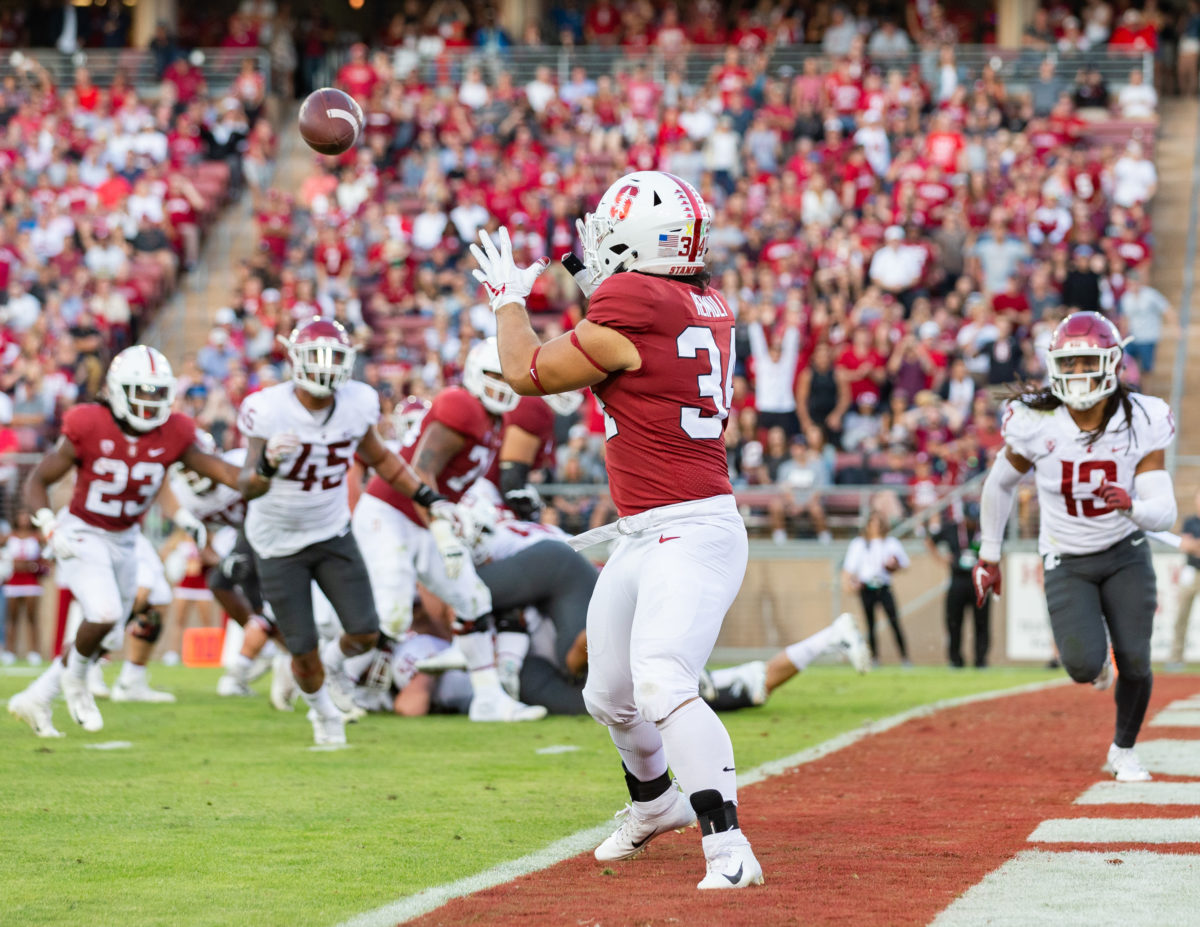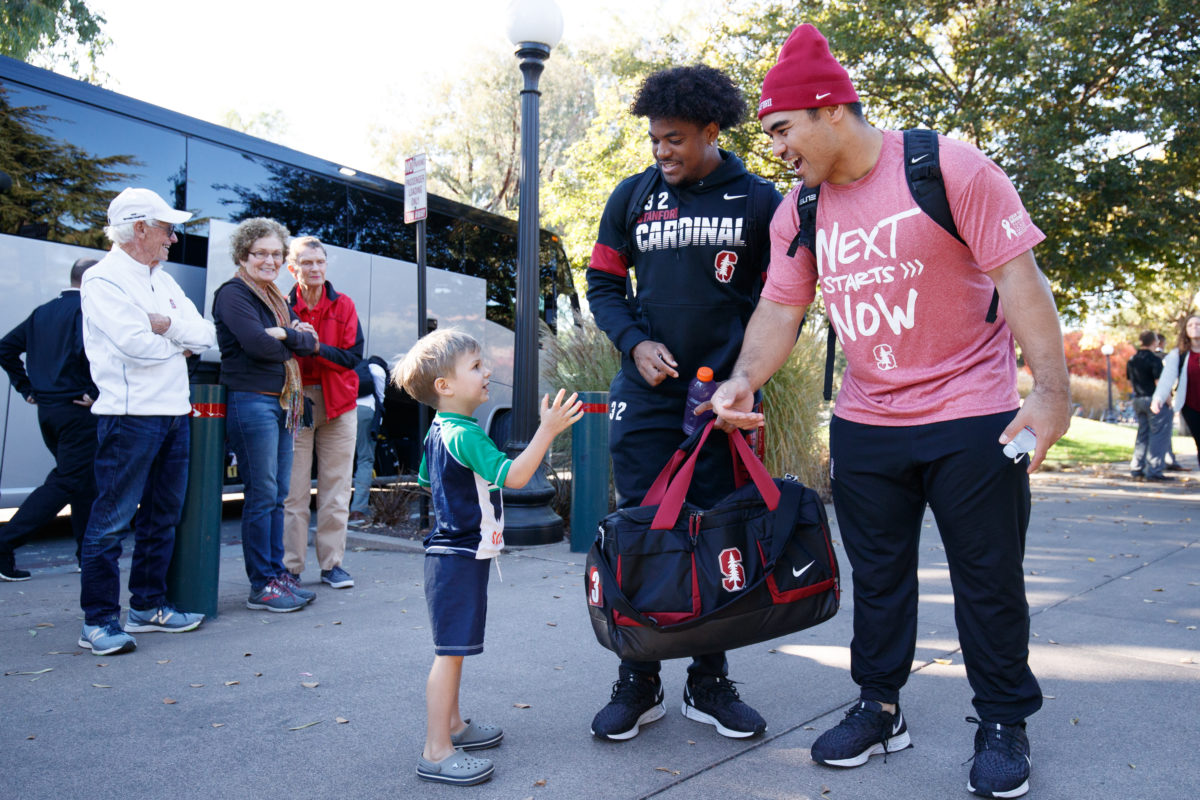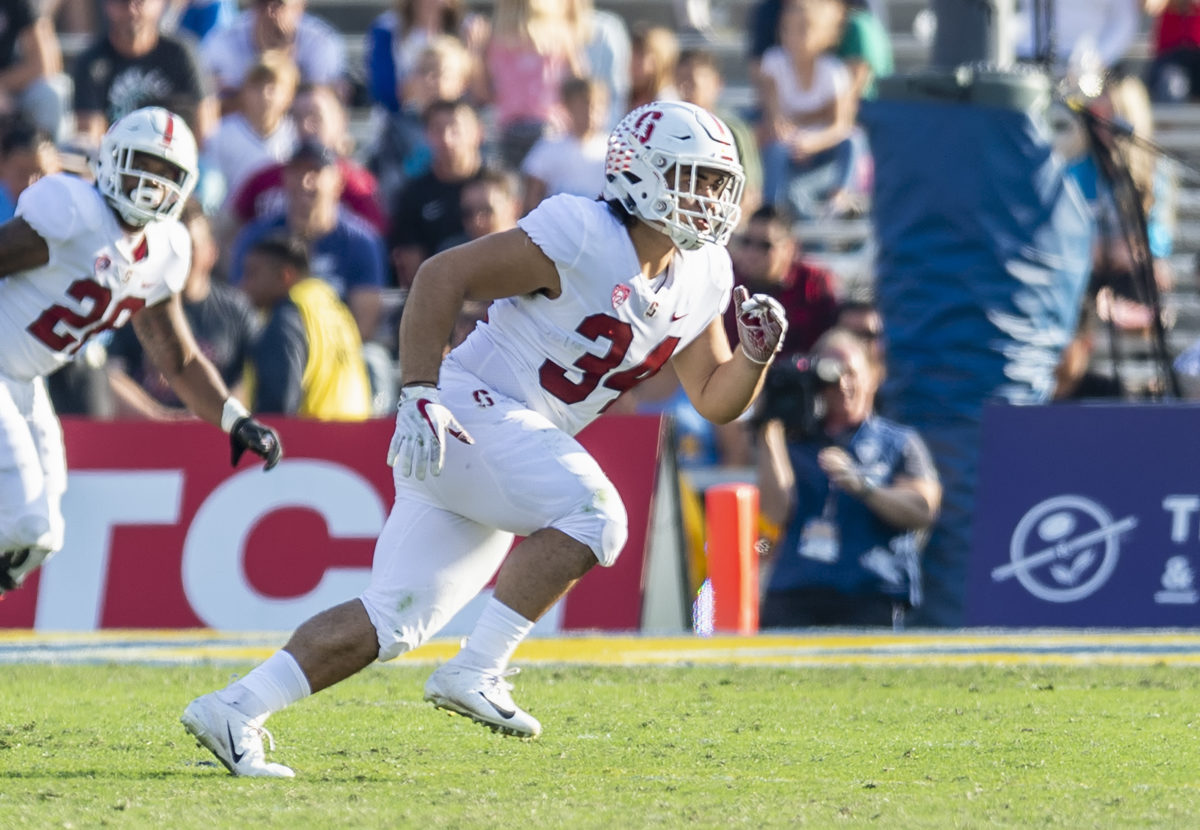In the history of the NFL, one would be hard-pressed to find a position that has undergone as many changes as fullbacks have. Once the superstars of the league and led by dynamic Hall of Famers like Jim Taylor and Jim Brown, just 14 of the 32 NFL teams held a fullback on the active roster last October, according to Over The Cap. Despite the fullback’s steady decline at the professional level, senior Houston Heimuli was not deterred from trying the position in high school.
“I didn’t really play anything but linemen growing up,” he said. “When I got to high school, my coaches were like hey, do you want to try anything else on our team? And I was like, ‘I’d love to be running back.’ But I was still fat and kind of slow. But they said, ‘You can try fullback for a second and see how you like it. I started playing it, and I just fell in love with the position — a jack of all trades type.”
The term fullback initially referred to the distance between the ball on the line of scrimmage and the position of the player. Quarterbacks were positioned 1/4 of a yard behind the ball, halfbacks (now more well-known by the all-encompassing term running back) were 1/2 of a yard behind the ball and fullbacks started one full yard behind the ball — all three position names are derived from the Irish nomenclature that was originally used to describe rugby player positions. Fullbacks were traditionally the primary ball carriers on a team, a role held now by the halfback. This change shifted fullbacks into a lead blocker role, rarely touching the ball.
The transition from linebacker to fullback worked out well for Heimuli. He committed to Stanford near the end of his high school career but took a two-year hiatus to serve on a Latter-Day Saints Missionary Program in Indianapolis before starting his career on the Farm two years later in 2018.
As college football has moved toward pass-first offenses, fewer teams are utilizing fullbacks as an integral part of their game script. The Cardinal, however, under head coach David Shaw, have still relied on their run game with an emphasis on offensive linemen, tight ends and plays out of the I-formation — a system that serves fullbacks well — to carry Stanford to seven bowl games in the last nine years.
In a run-first scheme, extra bodies are necessary to pick up extra blockers or provide extra push behind the offensive line to allow the running back to find gaps to pick up yardage. Heimuli has been used primarily as a blocker with the Cardinal, although he has caught four passes, including one touchdown, in his two years on the field. He redshirted his freshman season in 2017.

“One of my favorite memories was finally experiencing a college touchdown,” he said. “I never thought I’d get one.”
In 2018, Heimuli caught a one-yard touchdown pass from K.J. Costello ’20 with 1:04 remaining in the first half to put the Cardinal up 28-14 against No. 14 Washington State (WSU). Current Jacksonville Jaguars quarterback Gardner Minshew ultimately led WSU to a 41-38 victory, but the Cardinal’s last play of the first half stands as Heimuli’s most memorable football moment on the Farm.
Heimuli was also an integral blocker in both Bryce Love’s ’19 and Cameron Scarlett’s ’19 senior seasons. Love, who now plays for the Washington Football Team, rushed for nearly 750 yards and six touchdowns in 2018 and Scarlett, who was signed as an undrafted free agent by the Tennessee Titans last spring, rushed for nearly 850 yards and seven touchdowns in 2019 as a fifth-year senior.
Playing for a team that has a history of star running backs and fullbacks can certainly be daunting. Heimuli called his first practice in summer 2017 “scary” and “nerve-wracking” and said that he was making mistakes left and right. He has, however, become more comfortable with the team and has grown into a leadership role as an upperclassman.
“You realize everyone’s human, and everyone’s prone to mistakes,” Heimuli said. “That’s helped me now. I still make mistakes. I’m still learning, but I think the aspect of everyone’s human [helps]. Now I just work hard on whatever I do. And if a mistake happens, it happens.”
Because of Stanford’s long history of standout fullbacks, Heimuli had a large group to look up to and model his game after. He said he often tries to emulate David Marx ’18, one of the best fullbacks in recent history. Marx blocked for Heisman Trophy runners-up Christian McCaffrey ’18 and Love and helped the team reach more than 350 total rushing yards three times over his final two seasons on the Farm. He briefly practiced with a few different NFL teams but never earned a spot on an active roster and retired from football in 2019.
“[Marx] was here when I was a freshman,” Heimuli said. “I just loved watching him play and I still idolize him now.”
Heimuli also pointed to Reagan Williams ’19 as another fullback he looks up to. Although Williams never registered a touch as a running back as a Cardinal, he also blocked for McCaffrey and Love and helped them to career years in 2017 and 2018, respectively. Williams transferred to Rice University for his final year of eligibility.
Williams and Marx are “two guys I played with who I have looked up to and always wished I could be just like,” Heimuli said.

Because fullbacks don’t often touch the ball, misconceptions about the position are easy to develop. But, Heimuli contends, that doesn’t mean the position itself is easy. He likened playing fullback to a “physics game.”
“We’re not the biggest, and we’re not the fastest or the strongest necessarily, so we rely a lot on leverage,” he said. “We literally play physics against these defensive guys where our whole goal is just to get low and bend over and see if we can outmaneuver people. It’s a bruising position where it’s a lot of hard hitting, a lot of contact — but we do have a reason for some of the things we do on the field.”
For that reason, the “shelf life” of fullbacks in the NFL is similar to that of running backs. The average length of a professional career for running backs is just under three years, and it is rare to see many continuing to play into their thirties. Heimuli’s dream is to play professionally, but he also understands that an NFL career would likely be short and has a backup plan in place. As a human biology major, one of his long-term goals is to attend medical school and ultimately work as a pediatrician. His NFL prospects do look promising, however, as he was ranked as the No. 5 overall fullback in the 2021 draft class by ESPN draft analyst Mel Kiper in May.
For now, however, he is preparing for the shortened Pac-12 football season that will begin on Saturday, Nov. 7. Although the Cardinal just recently resumed practice and there is still uncertainty surrounding the upcoming season, Heimuli’s goals remain the same.
“I want to show people that I’m a contender,” he said. “I want to be noticed on a larger stage. I want people to know that, if [I am] in the game, expect something big.”
“If I do my 1/11th job,” he continued, “that will contribute to us becoming a championship team and a noteworthy team that people know and can look up to.”
Although the Cardinal are coming off of a 4-8 season, after which record-setting quarterback Costello transferred to Mississippi State and two stars — left tackle Walker Little ’21 and cornerback Paulson Adebo ’21 — have already opted out to prepare for the NFL draft, the team’s goal is still to win a championship.
Because Heimuli redshirted his first year on the Farm, he has an extra year of eligibility remaining after this upcoming season if he chooses. As of now, he is planning on playing out this year and his final year of eligibility with the Cardinal.

“I just take the mentality that every day counts,” Heimuli said. “Because every day counts, every little thing I do is going to contribute to the bigger picture.”
Although Heimuli did admit that he wished he had branched out even more as a freshman and tried different clubs, he reiterated that he did not regret any of his time at Stanford.
Overall, he said, “it’s a wonderful experience. I’ve had an exposure to so many different aspects of life that I don’t think I’ve ever been exposed to before, with sports, academics and the diversity of people at Stanford that you’d never meet at most schools.”
Contact Sofia Scekic at sscekic ‘at’ stanford.edu.
